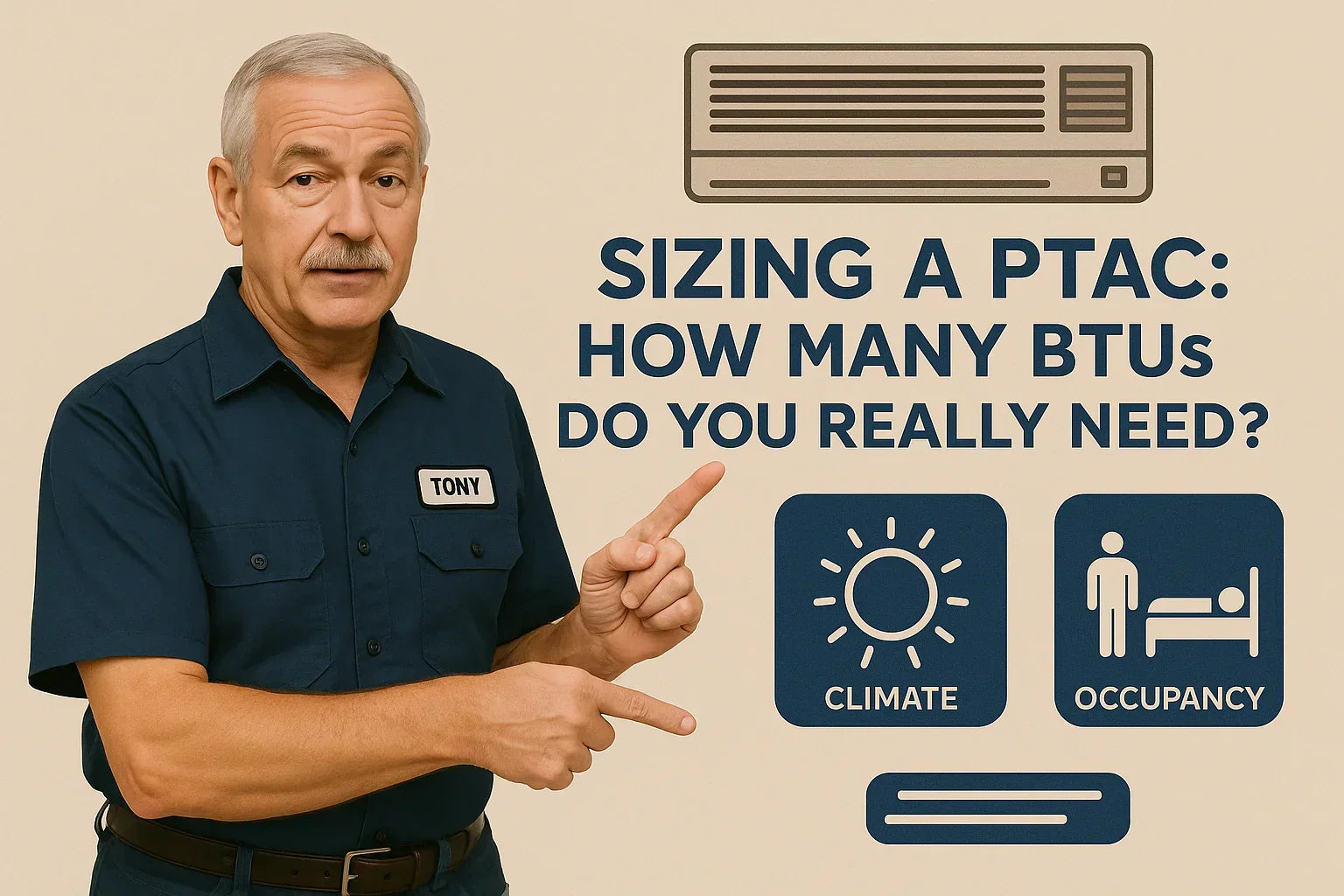🔄 Introduction: Why PTAC Sizing Matters
If you're investing in a Packaged Terminal Air Conditioner (PTAC), getting the size right isn't just a technical detail—it's the difference between efficient comfort and costly headaches. Oversized units short-cycle and waste energy. Undersized units struggle to keep up. As Tony Marino, I've seen building owners make both mistakes, and both cost you money. Let's break it down so you can size your PTAC right the first time.
📊 What Is BTU and Why Does It Matter?
BTU stands for British Thermal Unit — a measure of heat energy. When we say a PTAC is 12,000 BTU, it means it can move 12,000 BTUs of heat per hour.
Key rule of thumb:
The higher the BTU, the more cooling and heating capacity.
But bigger isn't always better. Proper sizing ensures:
-
Energy efficiency
-
Comfortable humidity levels
-
Consistent temperatures
-
Longer equipment lifespan
🛋 Base Sizing Rule of Thumb
The basic industry estimate:
20 BTU per square foot of conditioned space
| Room Size | Recommended BTU |
|---|---|
| 150-250 sq. ft | 5,000-6,000 BTU |
| 300-400 sq. ft | 7,000-9,000 BTU |
| 450-550 sq. ft | 10,000-12,000 BTU |
| 600-700 sq. ft | 13,000-15,000 BTU |
| 700-1,000 sq. ft | May require multiple PTACs |
Source:
https://www.consumerreports.org/central-air-conditioners/best-air-conditioner-buying-guide/
🌇 Factors That Affect PTAC Sizing
Beyond just room size, many variables impact what BTU capacity you really need:
1. Climate Zone
-
Hot, humid climates need more cooling BTUs.
-
Northern climates need more heating BTUs.
2. Sun Exposure
-
South- or west-facing rooms absorb more heat.
-
Rooms with large windows or glass doors often need 10-15% more BTUs.
3. Room Function
-
Kitchens or gyms generate internal heat loads.
-
Hotel conference rooms require higher capacity per square foot.
4. Ceiling Height
-
The 20 BTU/sq ft rule assumes 8-foot ceilings.
-
For high ceilings, adjust upward.
5. Insulation Quality
-
Poorly insulated walls or single-pane windows demand more capacity.
-
Well-insulated spaces need less.
6. Occupant Load
-
Add 600 BTUs per additional regular occupant.
7. Appliance & Electronics Load
-
Add 500-1,000 BTUs for heavy appliances, TVs, computers, etc.
ASHRAE Load Calculation Handbook:
https://www.ashrae.org/technical-resources/bookstore/load-calculation-applications-manual
🏨 Case Study: Hotel Room Example
Scenario:
-
Hotel room = 350 sq. ft
-
West-facing with full-glass balcony doors
-
9-foot ceiling
-
King bed with TV, mini-fridge, and two guests
-
Moderate insulation
-
Climate: Atlanta, GA
Base load: 350 sq ft x 20 = 7,000 BTU
-
Sun exposure: +10% (700 BTU)
-
Ceiling height: +10% (700 BTU)
-
Appliances: +500 BTU
-
Occupants: +600 BTU
Total recommended capacity: ~9,500 BTU
Closest PTAC size match: 9,000 - 12,000 BTU unit like Amana Distinctions 12,000 BTU PTAC gives you room for peak loads without oversizing.
🔄 The Problem With Oversizing
Many buyers assume "more is better." Not true for PTACs.
Oversizing causes:
-
Short cycling (turns on/off too frequently)
-
Wasted energy
-
Inconsistent room temperatures
-
Poor humidity control
-
Extra wear and tear on compressors
U.S. DOE Guide on Oversizing Risks:
https://www.energy.gov/energysaver/common-air-conditioner-problems
📅 The Problem With Undersizing
Undersized PTACs struggle to keep up on extreme days.
Undersizing causes:
-
Constant running (higher electric bills)
-
Never reaching set temperature
-
Overwhelmed electric backup heat
-
Accelerated unit failure
🔧 Heat Pump PTAC Sizing Considerations
The Amana Distinctions model includes a heat pump with electric backup.
Key sizing notes:
-
Heat pump sizing is critical for climates below 40°F
-
Allow for extra capacity to reduce reliance on electric backup
-
Heat pumps deliver full capacity more slowly than straight resistance heat
🌟 Tony's Pro Tips for PTAC Sizing
-
Use a formal load calculation if you're unsure.
-
Never rely on "same size as last time" unless building conditions haven't changed.
-
Bigger isn't always better—aim for balanced, steady operation.
-
If you're on the fence, slightly oversize for rooms with extreme sun or poor insulation.
-
Always account for future use (converting units, adding appliances, etc.).
🤝 When to Hire a Pro
If you're outfitting:
-
Entire hotels
-
Senior living facilities
-
Apartments or multi-unit complexes
Get a full Manual J Load Calculation done.
This accounts for:
-
Walls, ceilings, floors, windows, doors, people, lighting, appliances, and climate data.
🔒 Final Takeaway
Choosing the right PTAC size is part science, part common sense. If you're cooling a 350-square-foot hotel room, a 12,000 BTU PTAC like the Amana Distinctions model gives you solid performance with headroom for hot southern summers.
For apartments and assisted living suites, use precise load calculations to prevent sizing mistakes that haunt you with high bills or uncomfortable residents.
And always remember: A properly sized PTAC runs longer cycles, maintains steadier temperatures, removes humidity better, and lasts longer. That's comfort you can bank on.
In the next topic we will know more about: Installation Guide: Setting Up Your Amana Distinctions PTAC Safely







